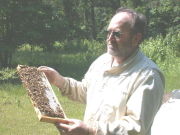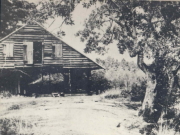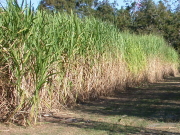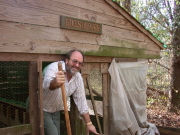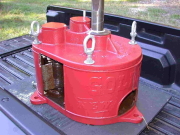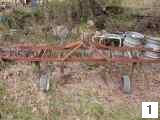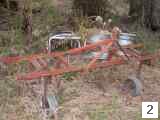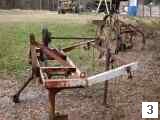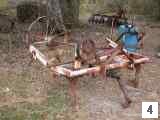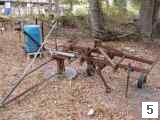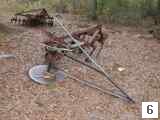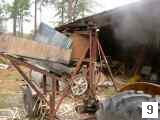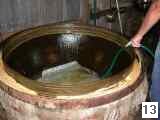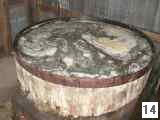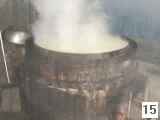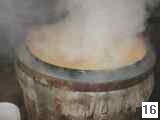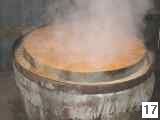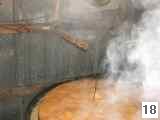Sandy’s Syrup (Tifton, Georgia)
Today’s occasional syrup maker, like the historical ones, can depend on hand labor. The 2002 NSSPPA conference, however, demonstrated that mechanical methods to reduce labor while preserving the essence of the craft are appealing to many who wish to operate commercially. Therefore, at the beginning of this site, I will show three custom-made implements that reduce labor in harvesting cane.
Slides 1 and 2 are different views of a hilling implement. Opposing moldboards throw soil to the center; wheels maintain the depth. Wide sweeps run the centers.
Slides 3 and 4 are different views of a cane-stripping implement. A circular band with flexible lines are powered by the tractor pto. The lines flail the leaf blades off as the band turns. Other designs call for several smaller bands mounted vertically; a variety of material has been used for line, including the line used on weed whackers
Slides 5 and 6 images are different views of a cane-harvesting implement. As the photographs show, a circular saw cuts the base of the cane off. Again, wheels control the height of the cut and the saw is powered through the pto. Other designs include a second blade for topping, a conveyer, and a guide, similar to that on corn pickers.
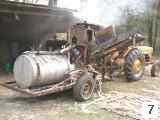 Syrup making begins with the
pressing set-up behind the syrup shed (slide 7). In essence, a tractor pto powers a Golden No.4x, with the
bagasse being conveyed in one direction and juice being collected in a large
container.
Syrup making begins with the
pressing set-up behind the syrup shed (slide 7). In essence, a tractor pto powers a Golden No.4x, with the
bagasse being conveyed in one direction and juice being collected in a large
container.
Compared with horizontal power mills, smaller vertical mills are, of course, much easier to find and are much less expensive. Therefore, many syrup makers have adapted a vertical mill to power ... As there are inquiries about these systems, three photographs (Slides 8, 9, and 10) show some detail about the power train. (Note that the right-angle drive also drives the bagasse carrier.)
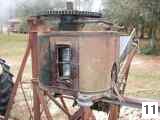 The center of the squeezing operation
is the mill, a Golden No. 4x (Slide
11). This is a heavy two-horse mill; as indicated elsewhere , it weighs 1300
pounds and was advertised to have a juice output of 150 gallons per hour. Rigged
as shown, it produces 260 gallons per hour.
The center of the squeezing operation
is the mill, a Golden No. 4x (Slide
11). This is a heavy two-horse mill; as indicated elsewhere , it weighs 1300
pounds and was advertised to have a juice output of 150 gallons per hour. Rigged
as shown, it produces 260 gallons per hour.
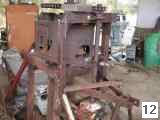 Slide 12, shows a Golden
No.2 that has been converted to be powered by a tractor pto. Although it is not
at Sandy’s, it might provide other details of interest to one who wishes to
make a mill conversion. In this instance, the right-angle drive was salvaged from
a peanut combine.
Slide 12, shows a Golden
No.2 that has been converted to be powered by a tractor pto. Although it is not
at Sandy’s, it might provide other details of interest to one who wishes to
make a mill conversion. In this instance, the right-angle drive was salvaged from
a peanut combine.
As the cane juice is evaporated to syrup in a kettle, its qualities obviously change as demonstrated in Slides 13, 14, and 15. At this location, fresh juice is pumped into one of the pair of 60-gallon kettles (slide 13). As the juice is heated, proteins, lipids and absorbed organics rise to the top. Called skimmings (slide 14), these impurities are removed as they rise (as done at this location) or after they form a blanket . The foam on the boiling juice is white at first (slide 15); at this stage, residual skimmings boil over the rim and are trapped in some fashion. Later, the bubbles on the top of the boiling syrup darken and the surface becomes uneven (slide 16); some syrup makers call this stage “puckering.” Near the end (slide 17), the syrup boils violently and uneven; this stage goes by various names (hominy flop, shooting ducks, hog’s eyes, calf’s eyes, frogs under a blanket, and perhaps others). The significance of having so many names for this stage probably relates to its importance: the syrup is nearly finished. At Sandy’s, the boiling temperature is monitored near the end with an automobile-type thermometer (slide 18), but the final decision to take up it relies on a hydrometer reading. Corn syrup, 2.5 gallons per kettle of syrup, is blended to form the final product.
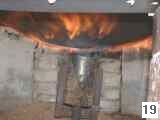 Throughout this site, various custom-made gas burners
have been illustrated. Slide 19 is another variation, a single burner with a single
11/64” orifice surrounded by a chimney.
Throughout this site, various custom-made gas burners
have been illustrated. Slide 19 is another variation, a single burner with a single
11/64” orifice surrounded by a chimney.
In closing, I wish to thank Sandy’s for the excellent fun-filled morning—few things beat a cool morning, boiling juice, and interesting companionship! The syrup was splendid.

